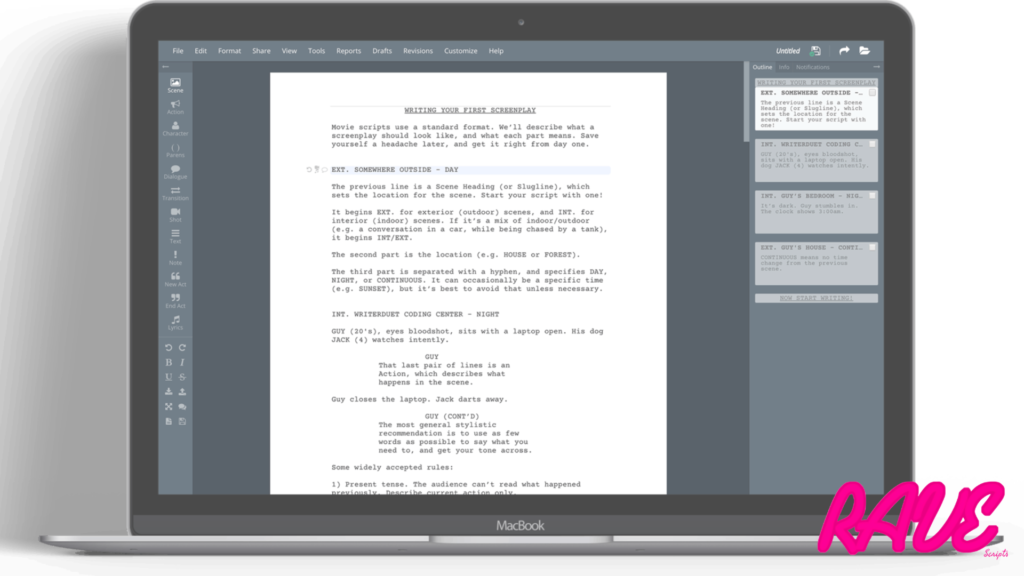A great ending can make or break a screenplay, leaving a lasting impression on the audience. The conclusion should wrap up loose ends, tie together themes, and provide a satisfying conclusion to the story. In this blog post, we’ll explore the different techniques for ending a screenplay and provide tips for crafting a memorable finale.
How To End a Screenplay: Tying Up Loose Ends

“Tying up loose ends” is a crucial aspect of ending a screenplay. A script that leaves unresolved questions or storylines can leave an audience feeling unsatisfied. To avoid this, make sure to address all of the main plot points and subplots in the finale. This can be done by revisiting them and showing how they have been resolved.
Characters and their motivations are also important to consider when tying up loose ends. If a character’s journey has been a central part of the story, it’s crucial that their arc is concluded in a meaningful way. The audience should understand what has changed for them, and how their story has come full circle.
Another aspect of tying up loose ends is resolving any lingering questions or mysteries. If the script has relied on suspense, twists or turns, the conclusion should provide answers to those questions. This will not only bring the story to a satisfying conclusion, but it will also help build trust with the audience.
World-building is another important aspect to consider when tying up loose ends. If the story takes place in a fantastical or science-fiction setting, it’s important to show how it has been impacted by the events of the story. This can include how characters have changed the world, or how it has changed them.
Minor characters and their roles in the story should also be addressed in the conclusion. If they played a significant role in the story, they should be given appropriate closure. On the other hand, if they only played a minor role, it’s okay to simply mention them in passing.
Lastly, when tying up loose ends, it’s important to do so in a way that is emotionally satisfying. The audience should feel that the characters have achieved what they set out to do, or have grown in meaningful ways. This can be achieved through powerful imagery, meaningful dialogues, or poignant moments.
How To End a Screenplay: Resolving Conflicts and Challenges

Here’s a list on how to resolve conflicts and challenges to end a screenplay:
- Clearly identify the main conflict or challenge of the story and address it in the conclusion.
- Show how the characters have grown or changed in response to the conflict.
- Provide a resolution that feels earned and satisfying, based on the events and choices of the story.
- Consider multiple solutions or outcomes, and choose the one that feels the most fitting for the story.
- Avoid using Deus ex Machina or introducing new information to resolve the conflict.
- Ensure that the resolution of the conflict or challenge aligns with the themes and motifs of the story.
- Use powerful visual, audio, and emotional cues to underline the resolution and its significance.
- Avoid resolving the conflict too easily or quickly, as this can undermine the tension and stakes established throughout the story.
- Consider how the resolution will impact the characters and their arcs moving forward.
- Use the resolution to provide closure to the audience and a satisfying conclusion to the story.
How To End a Screenplay: Providing Satisfying Conclusion

Providing a satisfying conclusion is key to a successful screenplay. It should wrap up the story in a meaningful way, and leave the audience feeling content. A satisfying conclusion can be achieved through several elements, such as resolution of the conflict, character arcs, themes, and tone.
When concluding a story, it’s important to consider the character arcs and how they have grown or changed throughout the story. The conclusion should show how their journey has come full circle and provide a sense of closure for the audience. This can be achieved through powerful dialogues, visual cues, or emotional moments.
Themes and motifs of the story should also be woven into the conclusion. By revisiting and emphasizing these themes, the audience will have a deeper understanding of the story and the events that have taken place. This can add depth and meaning to the conclusion and make it more impactful.
Tone is also an important consideration in providing a satisfying conclusion. The conclusion should reflect the overall tone of the story and provide closure in a way that feels consistent. Whether the story is dark and brooding or light and comedic, the conclusion should reflect this and provide a sense of resolution.
The conclusion should also provide closure to the audience by answering any questions that were raised throughout the story. This can include resolving plot twists, character motivations, and world-building elements. By doing this, the audience will feel that their investment in the story has been rewarded and the story will leave a lasting impact.
How To End a Screenplay: Making The Ending Impactful

- Build tension and suspense leading up to the conclusion to make it more impactful.
- Show, don’t tell, the resolution to the conflict or challenge in a visual and emotional way.
- Use powerful imagery and symbolism to reinforce the themes and motifs of the story.
- Create a sense of finality with a clear resolution and closure to the story.
- Craft a memorable final scene or moment that will stay with the audience long after the film is over.
- Use music, sound effects, and dialogue to heighten the emotions of the conclusion.
- Make sure the conclusion aligns with the overall tone and mood of the story.
- Avoid using cheap tricks or shortcuts to resolve the conflict or challenge.
- Offer a resolution that feels earned and satisfying based on the events and choices of the story.
- End on a note that is impactful and leaves a lasting impression on the audience.
How To End a Screenplay: Leaving Room For Sequel Possibilities

Leaving the ending of a screenplay open for sequel possibilities can be a great way to keep the audience engaged and interested. By creating a story with an open ending, the audience can imagine what might happen next and speculate on what might happen in a sequel. This can create a sense of anticipation and excitement, and leave a lasting impression on the audience.
To effectively leave the ending of a screenplay open for sequel possibilities, it’s important to build in a cliffhanger that raises questions or teases what might come next. This can be achieved through a plot twist, a revelation, or a dramatic moment that leaves the audience wondering what will happen next.
When considering a sequel, it’s important to think about the themes and motifs of the story, as well as the character arcs. The open ending should be a natural extension of these elements and offer a sense of progression. This will ensure that a sequel feels like a continuation of the story rather than a completely new story.
When crafting an open ending, it’s important to consider the world-building elements of the story. If the story takes place in a unique and interesting world, leaving the ending open for sequel possibilities can be a great way to explore this world further. This can include introducing new characters, exploring new locations, or expanding on existing elements of the world.
It’s also important to keep the audience engaged and invested in the story and its characters. By providing a resolution to the main conflict or challenge, the audience will feel satisfied with the story, but also be curious about what might happen next. This can be achieved through a clear resolution, but also by hinting at new conflicts or challenges that might arise in a sequel.
Ultimately, the key to leaving the ending of a screenplay open for sequel possibilities is to balance the need for resolution with the need for anticipation. By providing a satisfying conclusion, but also leaving the door open for more, the audience will feel engaged and invested in the story, and be eager to see what comes next.
How To End a Screenplay: Creating a Memorable Final Scene

Here’s a list on how to create a memorable final scene:
- Create a powerful emotional moment that resonates with the audience.
- Offer a visual image or symbol that reinforces the themes and motifs of the story.
- Use dialogue to drive home the resolution of the conflict or challenge.
- Provide closure to the character arcs in a meaningful way.
- Make use of music, sound effects, and other sensory elements to heighten the impact of the scene.
- Use imagery, dialogue, or other elements to reference important moments or themes from throughout the story.
- Balance the resolution of the conflict with a sense of anticipation or uncertainty.
- End on a note that is surprising, but also feels earned based on the events of the story.
- Create a scene that leaves a lasting impression on the audience, and stays with them after the film is over.
- Make sure the final scene is consistent with the overall tone and mood of the story.
Related:


Leave a Reply